
Once upon a time, Chinese food meant chilli chicken and chicken Manchurian. Now, thanks to the growing tribe of 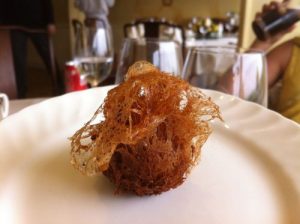 chefs from China, it is possible to get a more authentic taste of what Chinese food is all about.
chefs from China, it is possible to get a more authentic taste of what Chinese food is all about.
By definition, Chinese food in India can never be really authentic: food in China is usually cooked in pork fat, and organ meats – duck’s blood, chicken feet, rabbit’s head et al – are not only eaten, they’re elevated to an art form. Be aware, therefore, that what you get at those Chinese restaurants where Chinese chefs cook, is authentic enough, but conforms to Indian parameters.
There are as many chefs in Delhi today from Guangdong (the new name for Canton) as there are from Sichuan – the home of spicy food and Beijing – the capital, with young chefs being churned out of cooking schools. Singapore is where a related 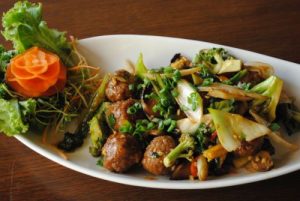 cuisine comes from, with the added advantage that Singaporean chefs are usually comfortable speaking English – an important consideration.
cuisine comes from, with the added advantage that Singaporean chefs are usually comfortable speaking English – an important consideration.
Delhi is witnessing a further refinement of yet another trend: the import of yet another Chinese sub-cuisine, this time from Hunan. It has been introduced at The Chinese, in Connaught Place. They’ve recently brought in three chefs from Hunan – a master-stroke, because while Hunan food, like its neighbour, Sichuan food, is spicy and thus well-suited to our palate, there is a whole new range of tastes making it a far more sophisticated cuisine than Sichuan with its three essential dimensions: spicy, spicier and spiciest. The menu at The Chinese offers something for every taste. 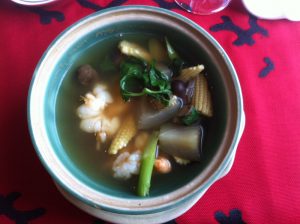 This restaurant has another claim to fame: it has a manageress who is a Chinese national. Amy is there as much to greet the army of Mandarin-speaking customers who make a bee-line here as to interact with the chefs who speak not a word of English.
This restaurant has another claim to fame: it has a manageress who is a Chinese national. Amy is there as much to greet the army of Mandarin-speaking customers who make a bee-line here as to interact with the chefs who speak not a word of English.
Tea flavoured prawn comes flambéed with tea leaves from Hunan. If that’s a masterpiece of subtlety, dry pot chicken is an incendiary dish with a mildly pickled flavour that is typical of Hunan cooking. The Chinese is the only Chinese restaurant where the chefs play with flavours, textures and spice levels in exactly the same way they do in China. There’s enough for vegetarians, for lovers of spice as well as for people who want to sample the original flavours of China. And the prices are not steep either.
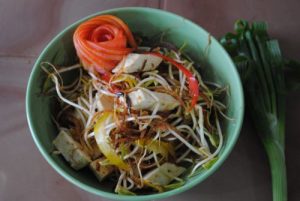 China Club serves Sichuan food: they have four chefs, all from Sichuan province. Sichuan and Hunan food, which together make up China’s south-western cuisine, is spicy enough to make you sweat, and thus to keep your body cool, like our very own Rajasthani or Andhraite cuisines. The team of chefs at China Club play with chopped red chilly, preserved red chilly, ye shan chilly (green chilly, fragrant with Shaoxing wine and vinegar) and the unique Sichuan pepper. The restaurant is quite rightly trying to upgrade its menu from a one-size-fits-all pan-Chinese one to a specifically Sichuan menu. However, unlike The Chinese, China Club is much more cautious in its approach. Chhonqing chicken, the legendary dish that comes served with a mountain
China Club serves Sichuan food: they have four chefs, all from Sichuan province. Sichuan and Hunan food, which together make up China’s south-western cuisine, is spicy enough to make you sweat, and thus to keep your body cool, like our very own Rajasthani or Andhraite cuisines. The team of chefs at China Club play with chopped red chilly, preserved red chilly, ye shan chilly (green chilly, fragrant with Shaoxing wine and vinegar) and the unique Sichuan pepper. The restaurant is quite rightly trying to upgrade its menu from a one-size-fits-all pan-Chinese one to a specifically Sichuan menu. However, unlike The Chinese, China Club is much more cautious in its approach. Chhonqing chicken, the legendary dish that comes served with a mountain 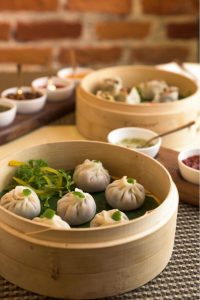 of chopped red chillies, is not available at China Club, though its Hunan version, Fregace Chicken, takes centre stage at The Chinese. On the other hand, China Club serves what is undoubtedly the best Beijing Duck in the city, edging out even Empress of China, albeit by a narrow margin.
of chopped red chillies, is not available at China Club, though its Hunan version, Fregace Chicken, takes centre stage at The Chinese. On the other hand, China Club serves what is undoubtedly the best Beijing Duck in the city, edging out even Empress of China, albeit by a narrow margin.
The other chef from the Sichuan province, Li Peng of Panasia at Marriott WelcomHotel excels in dumplings that have been expertly made. All the flours are imported, from rice flour to high gluten wheat flour to potato starch. Other restaurants too import their dimsum flours (you have to, if you want to stand up and be counted), but none make their dumplings with the care that Li Peng does. He’s innovative enough to add his own touches: his radish cake is encrusted with peanuts. Though he’s not a trained main course chef, he’ll sportingly oblige if he’s convinced that you want Chinese food on its own terms. I’ve had a stunning dinner consisting of lamb liver cooked in sweet soy, lamb’s trotters steamed with black bean and chilli, and stir-fried duck’s gizzard. None of them were on the menu, nor, given the Indian palate, will any of them be making their way to the menu anytime soon, but collectively they embody the interplay of textures that Chinese food is all about.
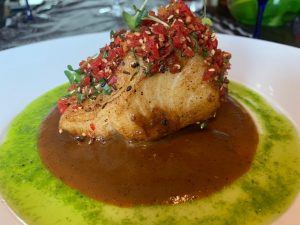 The Beijing brigade is represented by the enormously talented Yan Jun of Chef and I at Uppal’s Orchid, an Ecotel Hotel. Yan is essentially a dimsum chef whose creations include a spread of freshly set beancurd, fish in light soy sauce and chicken with black bean sauce. Of course, he also does dumpling-style dimsums, but he rues that in the Indian mind, dimsum equals only dumplings. If he’s sure you have the palate for adventure, he’ll set a dimsum feast before you (with advance notice). His main courses tend to have the assertive flavours of his native Beijing, of which lamb braised with star anise is the most representative. Like many others of his tribe, Yan carries a Pinyin to English palm-pilot with him, the better to converse in English. Pinyin is the official transliteration of Mandarin into the English script, and many of the younger lot of chefs have recourse to the bi-lingual palm-pilot during English conversations.
The Beijing brigade is represented by the enormously talented Yan Jun of Chef and I at Uppal’s Orchid, an Ecotel Hotel. Yan is essentially a dimsum chef whose creations include a spread of freshly set beancurd, fish in light soy sauce and chicken with black bean sauce. Of course, he also does dumpling-style dimsums, but he rues that in the Indian mind, dimsum equals only dumplings. If he’s sure you have the palate for adventure, he’ll set a dimsum feast before you (with advance notice). His main courses tend to have the assertive flavours of his native Beijing, of which lamb braised with star anise is the most representative. Like many others of his tribe, Yan carries a Pinyin to English palm-pilot with him, the better to converse in English. Pinyin is the official transliteration of Mandarin into the English script, and many of the younger lot of chefs have recourse to the bi-lingual palm-pilot during English conversations.
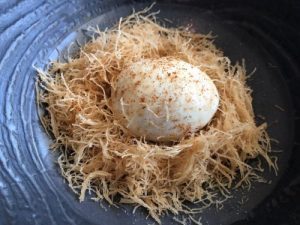 Sadly, you do have to declare your credentials when you walk into a Chinese restaurant. If the service staff thinks that you may want cornstarch-thickened soup and fried noodles with your chicken hot garlic sauce, they’ll make sure your order is not cooked by the Chinese chef! And even Chinese chefs themselves, after a couple of frustrating months in Delhi, begin to see the point of Ludhianvi-Chinese and hastily learn the rules!
Sadly, you do have to declare your credentials when you walk into a Chinese restaurant. If the service staff thinks that you may want cornstarch-thickened soup and fried noodles with your chicken hot garlic sauce, they’ll make sure your order is not cooked by the Chinese chef! And even Chinese chefs themselves, after a couple of frustrating months in Delhi, begin to see the point of Ludhianvi-Chinese and hastily learn the rules!
Ask any Chinese national where the country’s finest regional cuisine comes from, and all of them will unhesitatingly reply “Guangdong”. It’s where God made up for the barren desert of Western China by providing a cornucopia of seafood, the freshest of vegetables and 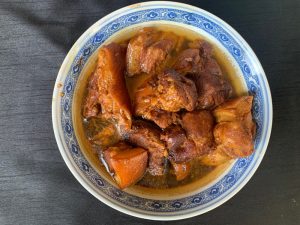 the tastiest of meats, especially pork and duck. The only problem is that Cantonese food is at the opposite end of the spectrum from North Indian tastes, which is why, if Sichuan food did not exist, it would have had to be invented.
the tastiest of meats, especially pork and duck. The only problem is that Cantonese food is at the opposite end of the spectrum from North Indian tastes, which is why, if Sichuan food did not exist, it would have had to be invented.
Nanking, owned by Baba Ling, whose forefathers were from Guangdong, is best known for dimsum. The dimsum chefs there also hail from Guangdong, arguably the home of the largest, most imaginative range of dimsum in China. The two brothers showcase their talent every weekend for brunch at the dimsum buffet that features char siu bao (pork buns), and dumplings made variously from taro starch, low-gluten flour and potato flour.
 Not surprisingly, Ano Tai at the Vasant Continental does an excellent job with seafood and pork – the two leading lights of Guangdong cuisine. He’ll do cold starters for you, which are an integral part of a Chinese meal in China, but which nobody here does, except for The Chinese. Char siu pork is sweet and mild, which contrasts well with the cooked-to-perfection fish with chilli oil that is topped with juliennes of green vegetables. He manages to imbue a dish of scallops with loads of flavour just by stir-frying them with bell peppers. Chef Tong is the only one of the Chinese chefs to have a Kolkata Chinese wife. Rosie, a former hair-dresser, speaks English, Hindi, Bengali, Mandarin and Cantonese while Chef Tong speaks nothing but Cantonese.
Not surprisingly, Ano Tai at the Vasant Continental does an excellent job with seafood and pork – the two leading lights of Guangdong cuisine. He’ll do cold starters for you, which are an integral part of a Chinese meal in China, but which nobody here does, except for The Chinese. Char siu pork is sweet and mild, which contrasts well with the cooked-to-perfection fish with chilli oil that is topped with juliennes of green vegetables. He manages to imbue a dish of scallops with loads of flavour just by stir-frying them with bell peppers. Chef Tong is the only one of the Chinese chefs to have a Kolkata Chinese wife. Rosie, a former hair-dresser, speaks English, Hindi, Bengali, Mandarin and Cantonese while Chef Tong speaks nothing but Cantonese.
The dark horse from Guangdong just has to be Chef Thomas Wee of Intercontinental Nehru Place. His job is to cook what his customers want him to, true, but if you ask him to make something special for you, he’ll oblige with a formal banquet, complete with cold lobster salad, steamed abalone cut into fancy shapes and seafood mousse formed into prawns. Like most other Chinese chefs in town, Chef Wee deeply 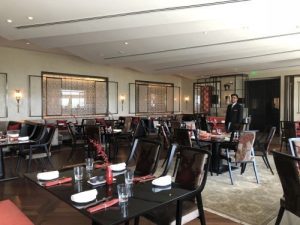 regrets that there are so few takers for authentic Chinese food.
regrets that there are so few takers for authentic Chinese food.
Which is why every time Chef Lo Ka Yan goes back to Hong Kong where he lives, or Guangdong, from where he hails, he visits restaurants compulsively to discover some new vegetarian dish that he can put on the menu at Tea House of the August Moon. He is the most talented and experienced chef in Delhi at the moment and his version of Cantonese food includes delightfully old-fashioned dishes that no modern chef has the patience to cook. Steamed duck with tofu, twists made from high-gluten flour in gravy scented with five spice powder and belly of pork slow braised with star anise.
Sadly, for a Chinese restaurant to get it right, it is not sufficient to merely hire an expatriate chef: fine-tuning is the order 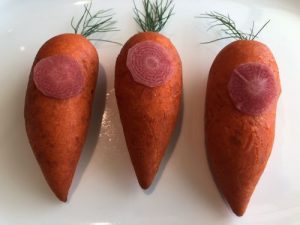 of the day. 19, Oriental Avenue at the Shangri La is still perfecting their recipe. One gets the impression that the Singaporean chef, James Ng, has been told to hold his horses on account of the Indian palate. I’ve had a superb tenderloin steak with HP sauce and fried onions Singapore style at the restaurant, but I’ve also had fried noodles served to me, as if he wasn’t quite sure how far he could stray from the straight and narrow. (In Chinese-speaking countries, noodles and fried rice constitute a separate meal altogether – they’re never eaten with main courses).
of the day. 19, Oriental Avenue at the Shangri La is still perfecting their recipe. One gets the impression that the Singaporean chef, James Ng, has been told to hold his horses on account of the Indian palate. I’ve had a superb tenderloin steak with HP sauce and fried onions Singapore style at the restaurant, but I’ve also had fried noodles served to me, as if he wasn’t quite sure how far he could stray from the straight and narrow. (In Chinese-speaking countries, noodles and fried rice constitute a separate meal altogether – they’re never eaten with main courses).
MBD Radisson’s Chef Raymond Sim has a huge fan following that has come to appreciate his coffee-flavoured pork ribs and Marmite-flavoured chicken for what they are: fusion food from Singapore. Sim turns his hand easily to Japanese, Korean and 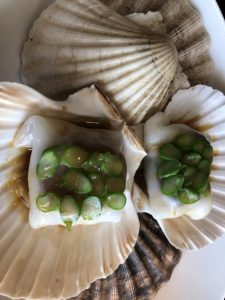 Thai food as well, all of which has a decidedly Singaporean feel to it. But the ease with which Singaporean chefs switch hats makes them attractive propositions for hotel bosses.
Thai food as well, all of which has a decidedly Singaporean feel to it. But the ease with which Singaporean chefs switch hats makes them attractive propositions for hotel bosses.
Taipan at The Oberoi, has always had chefs from Singapore, yet surprisingly, the Singapore bias in the menu has always been minimal: no wild fusion dishes here. Chef Thian Ng does do his bit for the Singaporean cause though. One of his best-sellers is a fish with lemon and turmeric sauce in the Nonya style; the other one is a cold starter featuring crunchy deep-fried prawns napped with mayonnaise scented with five spice powder and served with an apple salad. If few guests understand the dish – most are horrified at being served western food in a Chinese restaurant – most make a beeline for the dimsum for which Taipan has built an invincible reputation. ends
The Chinese, F 14-15, Connaught Place, Middle Circle; tel: 23708888, 55398888 Meal for two: Rs 1,400
China Club, Tower C, Global Business Park, MG Road, Gurgaon, tel: 95124-2566000 Meal for two: Rs 1,400
Panasia, Marriott WelcomHotel, Saket; tel: 26521122, ext. 1520 Meal for two: Rs 1,800
Chef and I, Uppal’s Orchid, NH 8, near IGI Airport; tel: 51511515 Meal for two: Rs 1,500
Nanking, Plot C-6, opp. Delhi Public School, Vasant Kunj; tel; 26138936-9 Meal for two: Rs 1,600
Ano Tai, Jaypee Vasant Continental, Vasant Vihar; tel: 26148800 Meal for two: Rs 1,800
Empress of China, InterContinental Nehru Place; tel: 26223344 Meal for two: Rs 1,800
Tea House of the August Moon, Hotel Taj Palace, Sardar Patel Marg; tel: 26110202 Meal for two: Rs 2,000
19 Oriental Avenue, Hotel Shangri-La, 19 Ashoka Road, Connaught Place; tel: 41191919 Meal for two: Rs 2,000
RED, MBD Radisson, L 2, Sector 18, Noida; tel: 95120-2515333 Meal for two: Rs 1,600
Taipan, The Oberoi, Dr Zakir Hussain Marg; tel: 24363030 Meal for two: Rs 2,000
All the above restaurants are open for lunch and dinner and are closed between 3 pm and 7 pm. All serve alcohol and accept credit cards

